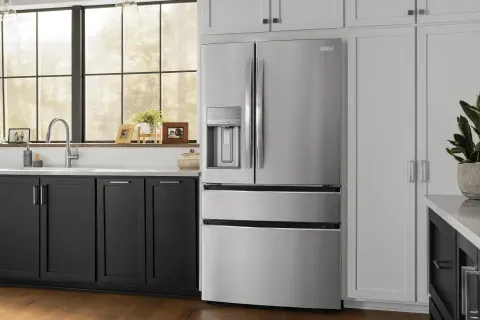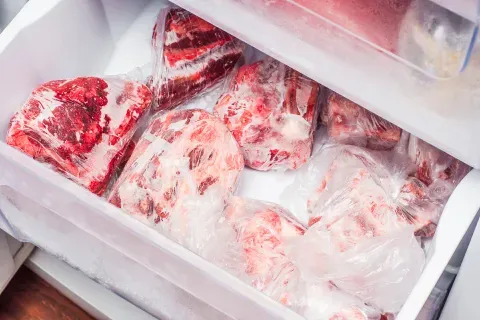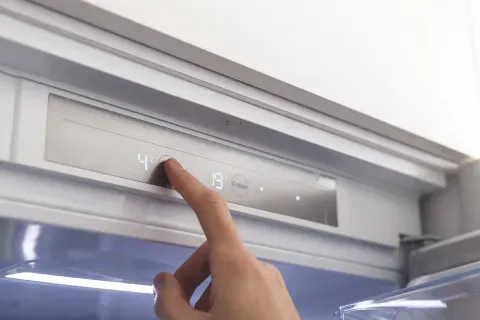How to Handle Food and Clean Your Refrigerator After a Power Outage
Thu Oct 03 2024
- Kitchen

Power outages are a major inconvenience, especially when it comes to keeping your food safe. Knowing how to handle food during and after a power outage can prevent foodborne illnesses and save you from unnecessary waste. Here’s a comprehensive guide to help you safely handle your food inside your refrigerator and freezer during these times and how to clean your appliances after the power is restored properly.
How Long Can Food Last in the Fridge Without Power?
During a power outage, once the power goes out, it’s crucial to take immediate steps to ensure your food remains safe within your appliances. Below is a list of detailed actions you can take to manage your refrigerator and freezer during a power outage:
Keep the Doors Closed
-
Refrigerator: When the door remains closed, the refrigerator will keep food safe for up to 4 hours. Avoid opening the door to maintain the cold temperature. Each time the doors are opened, cold air escapes, causing the internal temperature to rise.
-
Full Freezer: Will keep food frozen for up to 48 hours. A full freezer retains cold better than a half-full one. If you know a power outage is imminent, consider consolidating items to fill up your freezer.
-
Half-Full Freezer: Will keep food frozen for up to 24 hours. Consider adding ice packs or frozen water bottles to fill empty spaces and extend the freezing time.
Use a Cooler
-
After 4 hours, transfer perishable foods to a cooler with ice or frozen gel packs to keep the temperature below 40°F. This is especially important for items like dairy, meat, and leftovers. Make sure the cooler is well-insulated, and keep it in a cool, shaded place.
Evaluate Each Item Separately
-
Never Taste Food to Determine its Safety: Use a food thermometer to check temperatures. It should be discarded if the food has been above 40°F for more than 2 hours. Bacteria can grow rapidly at temperatures above 40°F, making food unsafe to eat.
-
When in Doubt, Throw It Out: Discard any perishable food like meat, poultry, fish, eggs, and any leftovers that have been above 40°F for more than 2 hours. It’s better to be safe than sorry.
Check the Temperature of the Appliances
-
Refrigerator: If the power is out for no more than 4 hours, food should be safe if the doors are closed. Check the temperature inside the refrigerator to ensure it is at or below 40°F.
-
Freezer: If the food still contains ice crystals or is 40°F or below, it is safe to refreeze or cook. Foods that have thawed but are still cold can be cooked and eaten.

Should You Unplug a Refrigerator During a Power Outage?
Do not unplug your refrigerator during a power outage. Thanks to its built-in surge protectors, keeping it plugged in protects it from damage when power is restored.
However, unplug smaller appliances like televisions, computers, game consoles, fans, and lights. These devices are more vulnerable to power surges, which can occur when electricity returns, potentially damaging their circuits. Unplugging them also reduces the load on the electrical system, making it safer for all your electronics.

How to Clean a Refrigerator After a Power Outage
Cleaning your refrigerator after a power outage is essential to ensure it remains hygienic and free from unpleasant odors. A thorough cleaning helps maintain the appliance and ensures that any spoiled food is removed, preventing contamination.
Here’s a step-by-step guide to help you clean your refrigerator effectively:
Step-by-Step Refrigerator Cleaning Process
-
Remove All Food Items: Discard any spoiled food. Take everything out of the refrigerator and freezer.
-
Clean the Interior: Use a mild dish soap and water mixture to clean the surfaces. Follow up with a baking soda solution (2 tablespoons baking soda with 4 cups warm water) to neutralize odors.
-
Eliminate Tough Odors: To remove persistent odors, use activated charcoal, coffee grounds, or a solution of vinegar and water. Place these items in the refrigerator for a few days to absorb any remaining smells.
-
Dry Thoroughly: Ensure the refrigerator is completely dry before restocking. Moisture can lead to mold growth and further odors.

Additional Tips for Food Safety
Foods You Can Keep
-
Hard Cheeses: Parmesan, Romano, and other hard cheeses are safe to keep.
-
Butter and Margarine: These items can withstand higher temperatures for short periods.
-
Fruit Juices and Canned Fruits: These are generally safe unless they have been opened.
-
Condiments: Mustard, ketchup, pickles, and other condiments are usually safe.
-
Breads and Baked Goods: Rolls, cakes, muffins, and other baked goods can be kept.
-
Raw Vegetables and Herbs: These can be kept unless they show signs of spoilage.
Foods to Discard
-
Perishable Items: Meat, poultry, fish, eggs, and leftovers should be discarded if they have been above 40°F for more than 2 hours.
-
Dairy Products: Milk and soft cheeses should be discarded if they have been above 40°F for more than 2 hours.
Upgrade Your Food Storage With Queen City
Preparation and quick action are key to minimizing food waste and preventing foodborne illnesses. Remember, when in doubt, throw it out!
Ready to elevate your food storage game? Explore Queen City's range of refrigerators for sale that can help you prepare for power outages with better cooling power and cost-saving, energy-efficient features. Explore our French Door Refrigerators, Side-by-Side Refrigerators, Built-in Refrigerators, and more to find the perfect fit for your kitchen.
Contact us or visit one of our local Queen City appliance store locations across North Carolina to explore new refrigerators for sale.
Related readings from our blog:
Frequently Asked Questions About Cleaning and Food Safety After a Power Outage
Can a power outage ruin your refrigerator?
A short outage usually won’t damage your refrigerator. However, long outages or power surges when the power is restored can lead to mechanical issues.
What should you throw out of the fridge after a power outage?
Perishable items like meat, poultry, fish, eggs, dairy products, and leftovers should be discarded if they have been above 40°F for more than 2 hours.
Can you spray vinegar in the fridge?
Yes, vinegar is a natural disinfectant and deodorizer, making it safe and effective for cleaning your fridge.
Why won’t my refrigerator work after a power outage?
It may be due to a tripped circuit breaker, a power surge, or internal damage. Check the breaker and, if necessary, reset it.
Is cheese still good after a power outage?
Hard cheeses are usually safe, but soft cheeses that have been above 40°F for more than 2 hours should be discarded.
Is butter okay after a power outage?
Butter can usually withstand higher temperatures for short periods but check for changes in texture or smell.
Related Articles
Sign up for specials, offers and more!
Welcome to our website! As we have the ability to list over one million items on our website (our selection changes all of the time), it is not feasible for a company our size to record and playback the descriptions on every item on our website. However, if you are an American with a disability we are here to help you. Please call our disability services phone line at 309-691-4100 during regular business hours and one of our kind and friendly personal shoppers will help you navigate through our website, help conduct advanced searches, help you choose the item you are looking for with the specifications you are seeking, read you the specifications of any item and consult with you about the products themselves. There is no charge for the help of this personal shopper for any American with a disability. Finally, your personal shopper will explain our Privacy Policy and Terms of Service, and help you place an order if you so desire. Copyright © 2009 - 2023 Company All Rights Reserved.
Copyright © 2009 - 2025 Company All Rights Reserved.
This site is protected by reCAPTCHA and the Google Privacy Policy and Terms of Service apply.



.webp)




